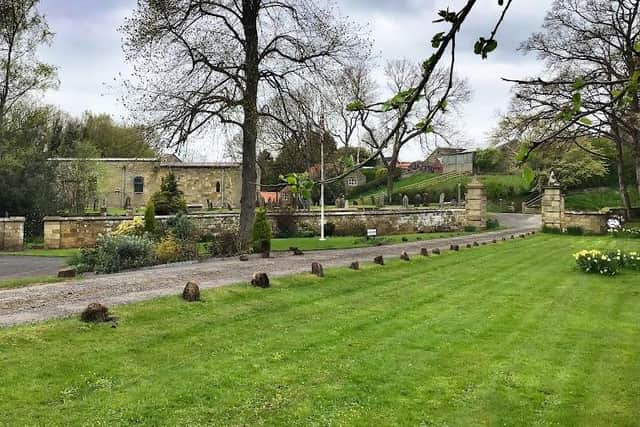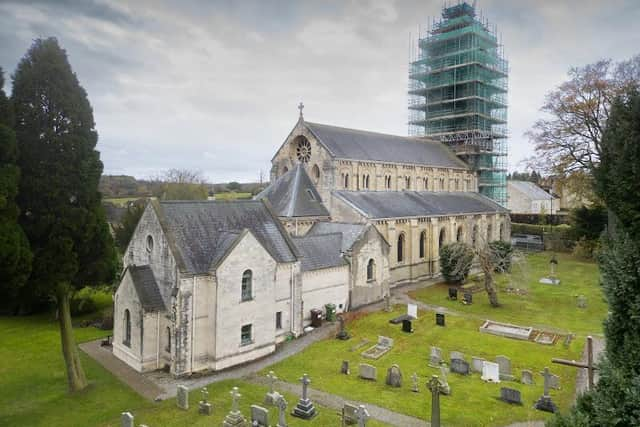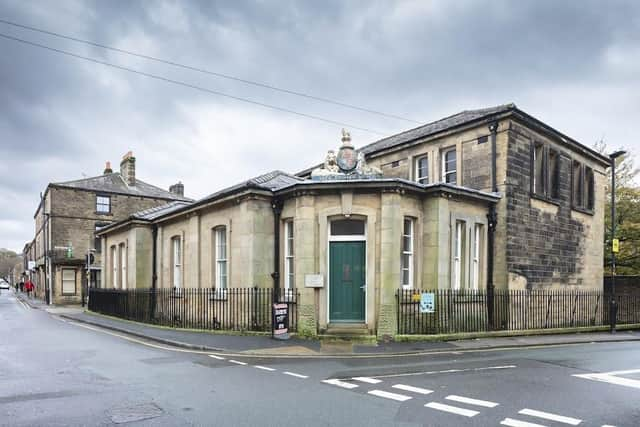The sixteen Yorkshire buildings listed for the first time in 2022 - including courthouse, graves, and John Lewis store
The eclectic mix includes graves in a Victorian cemetery in Leeds, the walls of a country estate near Great Ayton, several buildings in Dewsbury town centre and a controversial 1970s sports centre in Bradford.
In Sheffield, the iconic Cole Brothers/John Lewis department store has been listed alongside a 20th-century church, and Skipton’s old county courthouse now has protected status. Some of those on the list have had their listing categories upgraded.
Advertisement
Hide AdAdvertisement
Hide AdSt Edward’s Catholic Church, Clifford, near Wetherby – upgraded to Grade II*


An impressive mid -19th century Roman Catholic church - grand enough to be a city cathedral but built to serve a small Yorkshire village and a testament to local Catholic grassroots activism.
The story of the Church of St Edward the Confessor in Clifford reads like a film script - its construction shows triumph over adversity as a strong local family, driven by faith, raised funds to build it and thus re-establish a strong Roman Catholic community in this corner of West Yorkshire.
The Grimston family were committed to spreading their faith. They were descended from the Blessed Ralph Grimston, who martyred in York during the persecution of Catholics under Elizabeth I.
Advertisement
Hide AdAdvertisement
Hide AdThey established a mill in Clifford specifically to employ Roman Catholics who were often discriminated against by other employers. Then, working with local families, they set about raising money from across Europe to build the Church of St Edward King and Confessor. They succeeded – and the church opened its doors 1848, at a time when it was still difficult to worship as a Catholic in England.


Impressive in scale and architectural ambition, the church has a strikingly bold, French-influenced Romanesque style and features high quality sculptural decoration. Perhaps the most striking feature is the exceptionally tall tower, added by the notable architect George Goldie in 1868.
There are 26 stained glass windows, ranging in date from 1848-1986. This includes two in the north aisle by the famous architect, artist and designer Augustus Pugin.
Inside the church, beneath the main altar, is a sarcophagus containing the remains of an early Roman child martyr, St Domitia the Second. The Lady Chapel contains what has been described as ‘the most beautiful statue of the Mother of God to be found in Christendom’. This was carved by the Jewish sculptor Karl Hoffmann who is said to have converted to Catholicism whilst creating it.
Former Skipton County Court - listed at Grade II
Advertisement
Hide AdAdvertisement
Hide Ad

A Victorian county court designed by the architect to the Metropolitan Police, Charles Reeve, between 1856-57.
Situated on a prominent corner in the town centre, Skipton’s former County Court was purpose-built following the Act of 1846 which allowed a national system for the recovery of small debts. It highlights the great desire to extend the jurisdiction of the county courts with the creation of a new type of building.
The 166-year-old court was designed in Italianate style. It was constructed with two entrances to provide separate routes for the public and the judiciary. The building has survived well and still has many original features including a brick-vaulted and stone-lined Chubb and Sons walk-in safe, the public's entrance vestibule and hall and the Italianate wall scheme in the courtroom.
The court relocated in 2003 and subsequent occupants have included a law firm and a church.
Advertisement
Hide AdAdvertisement
Hide AdSt Theresa’s Catholic Church, Sheffield – listed at Grade II
Between the 1950s and the 1970s, if the Catholic Church wanted a new place of worship in South Yorkshire there’s a good chance they’d have given John Rochford a call. The Sheffield-based architect designed and adapted many churches in his career, one of the most notable of which is St Theresa’s Church in the city.
Completed in 1960, the church provides a prominent focal point amongst the inter- and post-war housing of the large Manor estate. Boldly designed in a modern Byzantine style, it boasts an eye-catching green copper-covered dome, which sits on top of a brick drum embellished with large relief panels of the twelve Apostles. Over the west door is a sculpture of St Theresa by sculptor Philip Lindsey Clark, acclaimed for his religious works.Estate walls and gate piers at Ingleby Manor, Ingleby Greenhow, North York Moors – listed at Grade II
Ingleby Manor was built in 1540 by Sir William Eure, a soldier and courtier of Henry VIII. The handsome house was surrounded by extensive parkland and, at some point in the late sixteenth or early seventh century, walls were added to enclose the estate. Built to a high standard of workmanship and employing a design based on the Manor’s Classical architectural detailing, the walls and their gate piers clearly meant to impress locals and visitors.
Advertisement
Hide AdAdvertisement
Hide AdThe walls have two gateways: one enabling carriages to enter the estate and another one which gave the Lord of the Manor and his family private entry to the churchyard of the adjacent Grade I-listed Church of St Andrew so they didn’t have to mingle with the villagers.
The Eures were later replaced by the Foulis family, the last of whom sold the estate in 1951 and it is in private ownership today, with the house available as holiday accommodation.
The other listings
18-29 King Edward Street and 49-51 Vicar Lane in Leeds city centre have been added at Grade II. They were built in 1898-1904 as part of the County Arcade development, which replaced the old yards around the meat market and butchers’ shambles with more upmarket shops, offices and cafes.
Past uses include King Edward Restaurant, the King Edward Hotel pub, a bank and shops including pram retailer Siller Ltd. One of the current occupants is Hip Store.
Advertisement
Hide AdAdvertisement
Hide AdThe heritage of Dewsbury is recognised by the inclusion of 18, 20 and 22 Bond Street and the former Fox’s auction house at 214 Grove Street. Number 18 was built in 1871 as a warehouse for leather merchants Crawshaw & Sons. Numbers 20 and 22 date from the 1860s, and were a warehouse for wool stapler Matthew Grandidge. 20 was later used as council offices before the town hall was built, and is now a solicitor’s offices.
Perhaps controversial is the listing of the Richard Dunn Sports Centre in Odsal – which Bradford Council have opposed. Built in 1974 and named after the local boxer, it closed in 2019 due to extremely high running costs and was set to be demolished before the Twentieth Century Society requested to have it listed. The council argue that it is expensive to maintain when not in use and had hoped to redevelop the site.
An emotional listing for residents of Sheffield is the former Cole Brothers, later John Lewis, department store. Cole Brothers started in the city in 1847, and the business was acquired by John Lewis in 1940, with the name retained. During the Sheffield Blitz, it was the only one of Sheffield’s six major department stores to escape bomb damage, but this proved disadvantageous in the postwar years as the others moved into more modern premises. John Lewis commissioned the building of a new store in the 1960s, and it was a much-loved retail destination until its recent closure. The building’s future is uncertain.
The Sun Pavilion and Sun Colonnade in Valley Gardens in Harrogate have been listed. They opened in the 1930s, were designed in Art Deco style, and are a rare surviving example of spa architecture from the period. They are still in use as a hospitality venue today.
Advertisement
Hide AdAdvertisement
Hide AdThe New Beehive Inn in Bradford has been lost as a public house but the building, dating from 1901, has now been given protection. It is unusual in that it was built for and run by a local council, the Bradford Corporation, and had four rooms centred around a drinking lobby. The 1901 decoration survives, as do parts of a 1936 refurbishment.
It was leased to licensees until 1957, the Corporation having sold it to brewers William Whittaker & Co in 1920. In 1959 it was taken over by Leeds brewery Tetley’s, and it was theirs until 1982, when Trough Brewery bought it and renamed it The Bradfordian.
New owner William Wagstaff restored the original name in 1989. It closed in 2022 and has now been sold to an Indian restaurant.
Several intriguing listings are graves at St George’s Fields Cemetery in Leeds, the Victorian burial ground. They include those of William and Susannah Darby. William was a well-known circus impresario and the country’s first black circus owner, the son of an African servant at a house in Norfolk. His wife Susannah was killed when seating collapsed on her during a performance in Leeds.
Advertisement
Hide AdAdvertisement
Hide AdGeorge Thwaites was the innkeeper of the Spotted Cow on Vicar Lane, and his family plot was one of those undisturbed and left to remain when the former Woodhouse Cemetery was landscaped as public open space in the 1960s. Another grave part of this group is that of stonemason Albert Horner.
